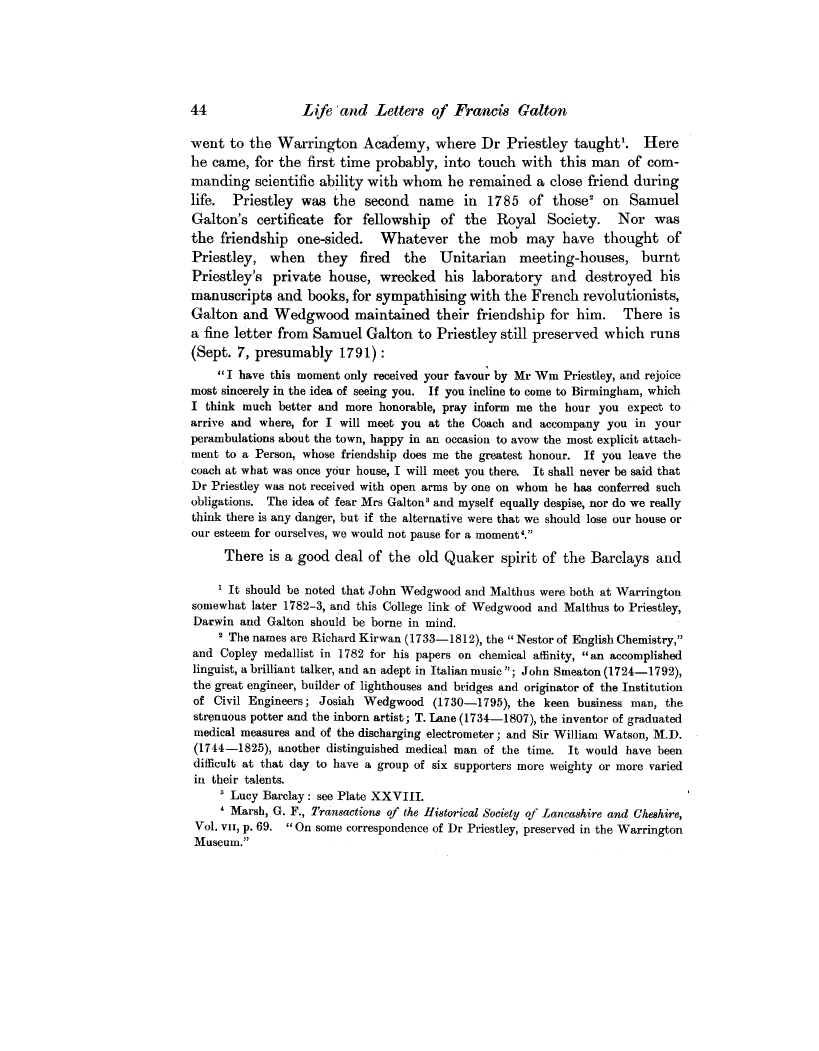| ||||||

OCR Rendition - approximate
44 Life ' and Letters of Francis Galton went to the Warrington Academy, where Dr Priestley taught'. Here he came, for the first time probably, into touch with this man of commanding scientific ability with whom he remained a close friend during life. Priestley was the second name in 1785 of those' on Samuel Galton's certificate for fellowship of the Royal Society. Nor was the friendship one-sided. Whatever the mob may have thought of Priestley, when they fired the Unitarian meeting-houses, burnt Priestley's private house, wrecked his laboratory and destroyed his manuscripts and books, for sympathising with the French revolutionists, Galton and Wedgwood maintained their friendship for him. There is a fine letter from Samuel Galton to Priestley still preserved which runs (Sept. 7, presumably 1791) "I have this moment only received your favour by Mr Wm Priestley, and rejoice most sincerely in the idea of seeing you. If you incline to come to Birmingham, which I think much better and more honorable, pray inform me the hour you expect to arrive and where, for I will meet you at the Coach and accompany you in your perambulations about the town, happy in an occasion to avow the most explicit attachment to a Person, whose friendship does me the greatest honour. If you leave the coach at what was once your house, I will meet you there. It shall never be said that Dr Priestley was not received with open arms by one on whom he has conferred such obligations. The idea of fear Mrs Galton' and myself equally despise, nor do we really think there is any danger, but if the alternative were that we should lose our house or our esteem for ourselves, we would not pause for a moment4." There is a good deal of the old Quaker spirit of the Barclays and i It should be noted that John Wedgwood and Malthus were both at Warrington somewhat later 1782-3, and this College link of Wedgwood and Malthus to Priestley, Darwin and Galton should be borne in mind. 2 The names are Richard Kirwan (1733-1812), the "Nestor of English Chemistry," and Copley medallist in 1782 for his papers on chemical affinity, "an accomplished linguist, a brilliant talker, and an adept in Italian music"; John Smeaton (1724-1792), the great engineer, builder of lighthouses and bridges and originator of the Institution of Civil Engineers; Josiah Wedgwood (1730-1795), the keen business man, the strenuous potter and the inborn artist; T. Lane (1734-1807), the inventor of graduated medical measures and of the discharging electrometer; and Sir William Watson, M.D. (1744-1825), another distinguished medical man of the time. It would have been difficult at that day to have a group of six supporters more weighty or more varied in their talents. ' Lucy Barclay : see Plate XXVIII. 4 Marsh, G. F., Transactions of the Historical Society of Lancashire and Cheshire, Vol. vii, p. 69. "On some correspondence of Dr Priestley, preserved in the Warrington Museum."
|